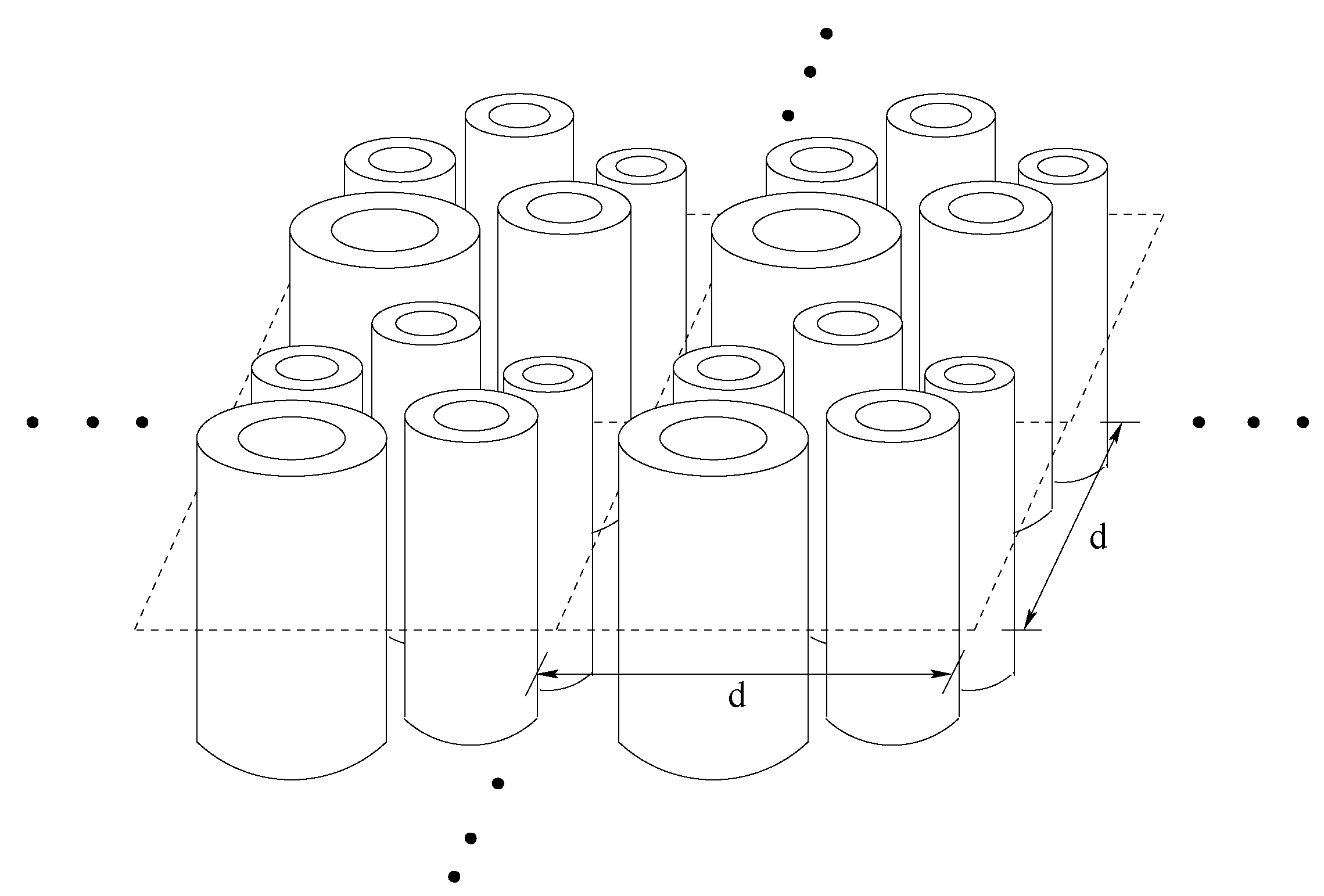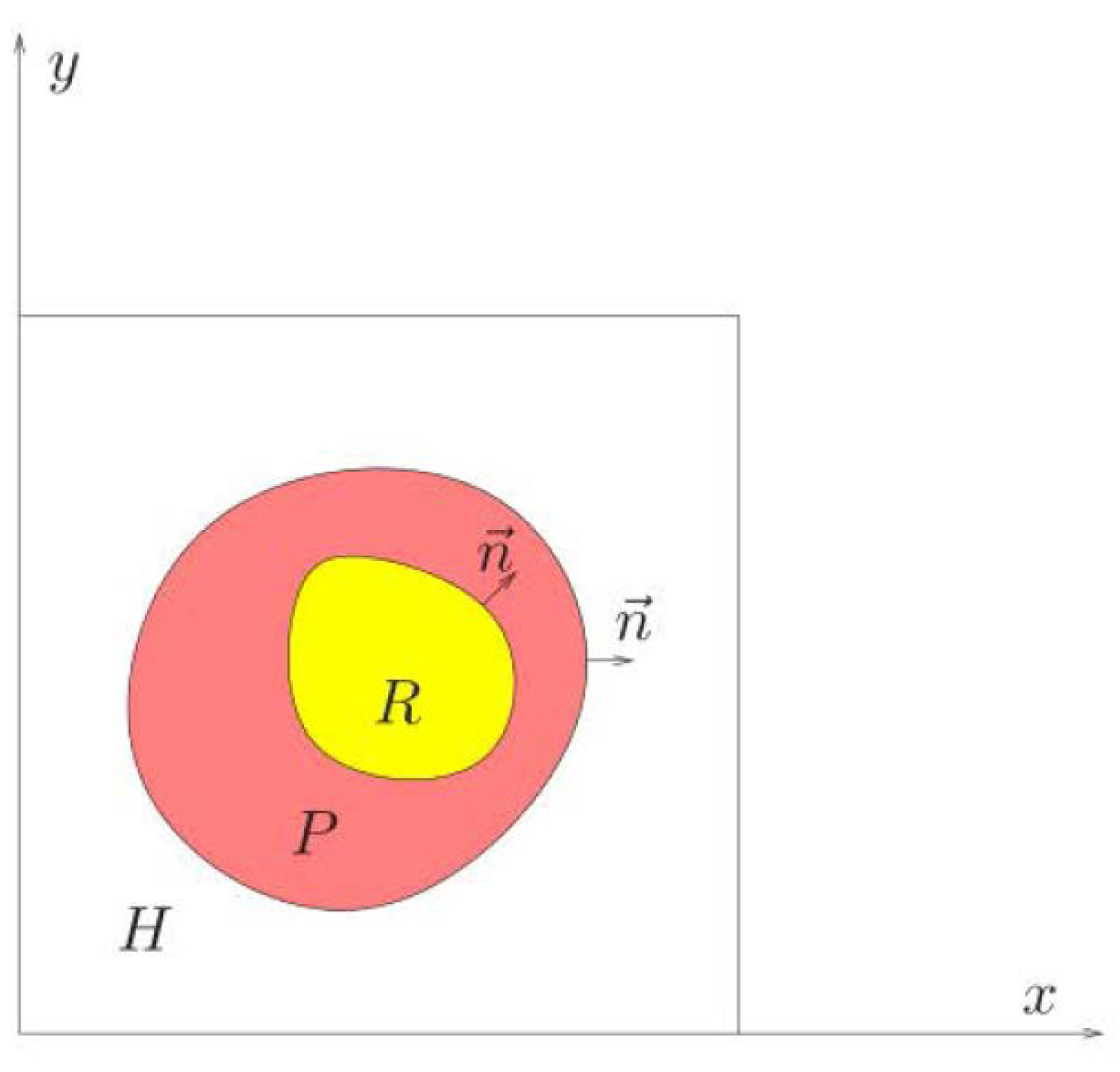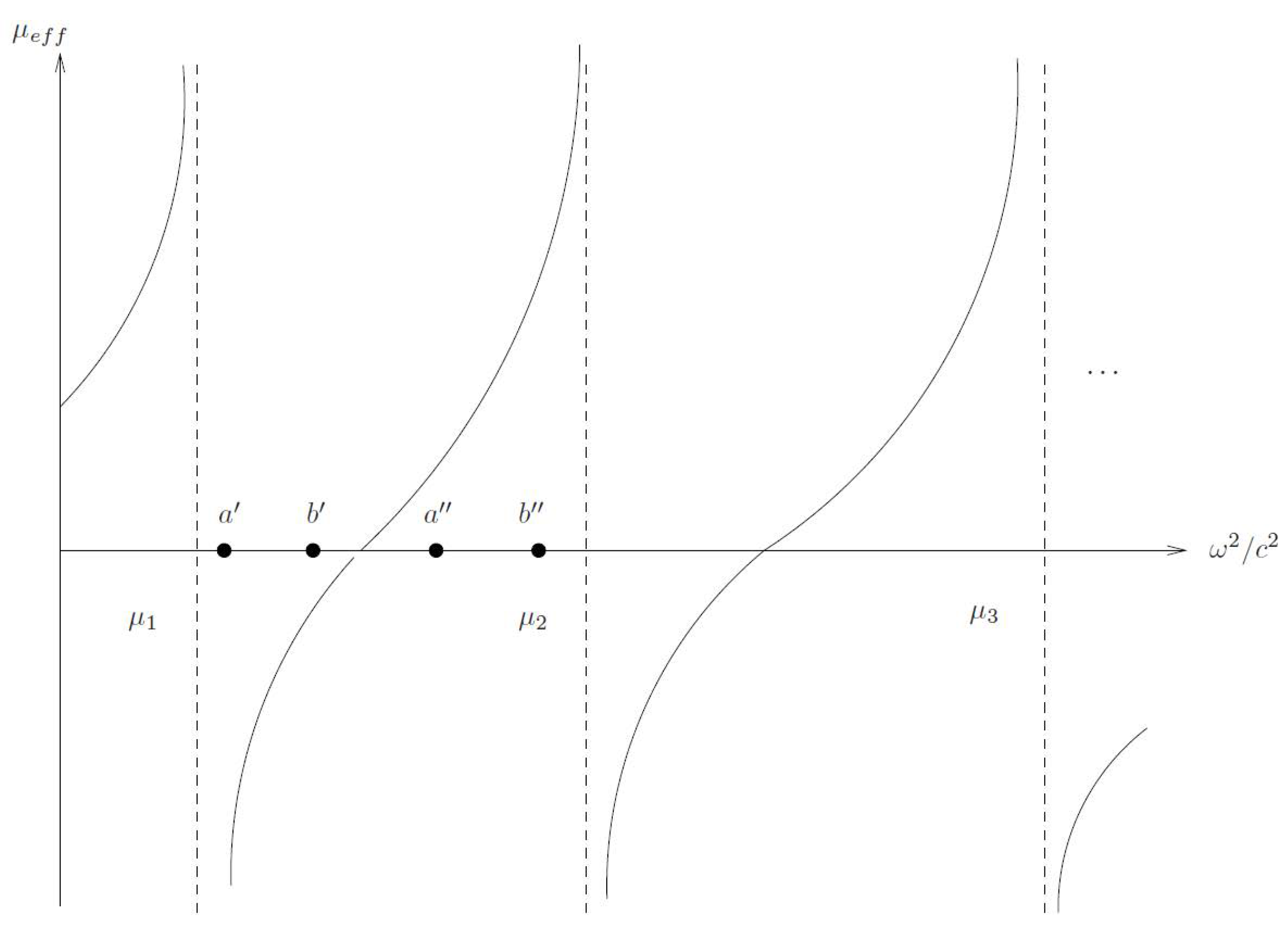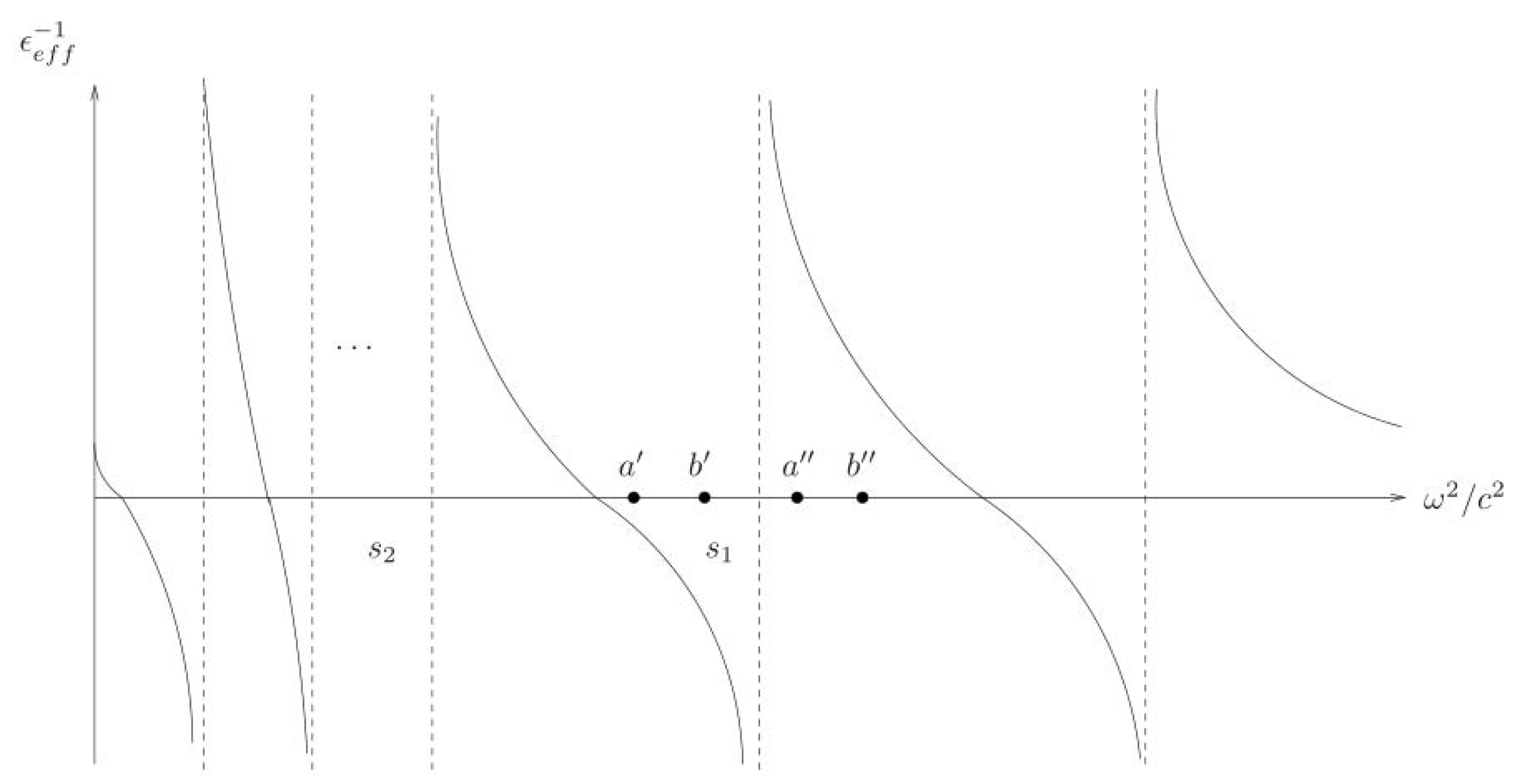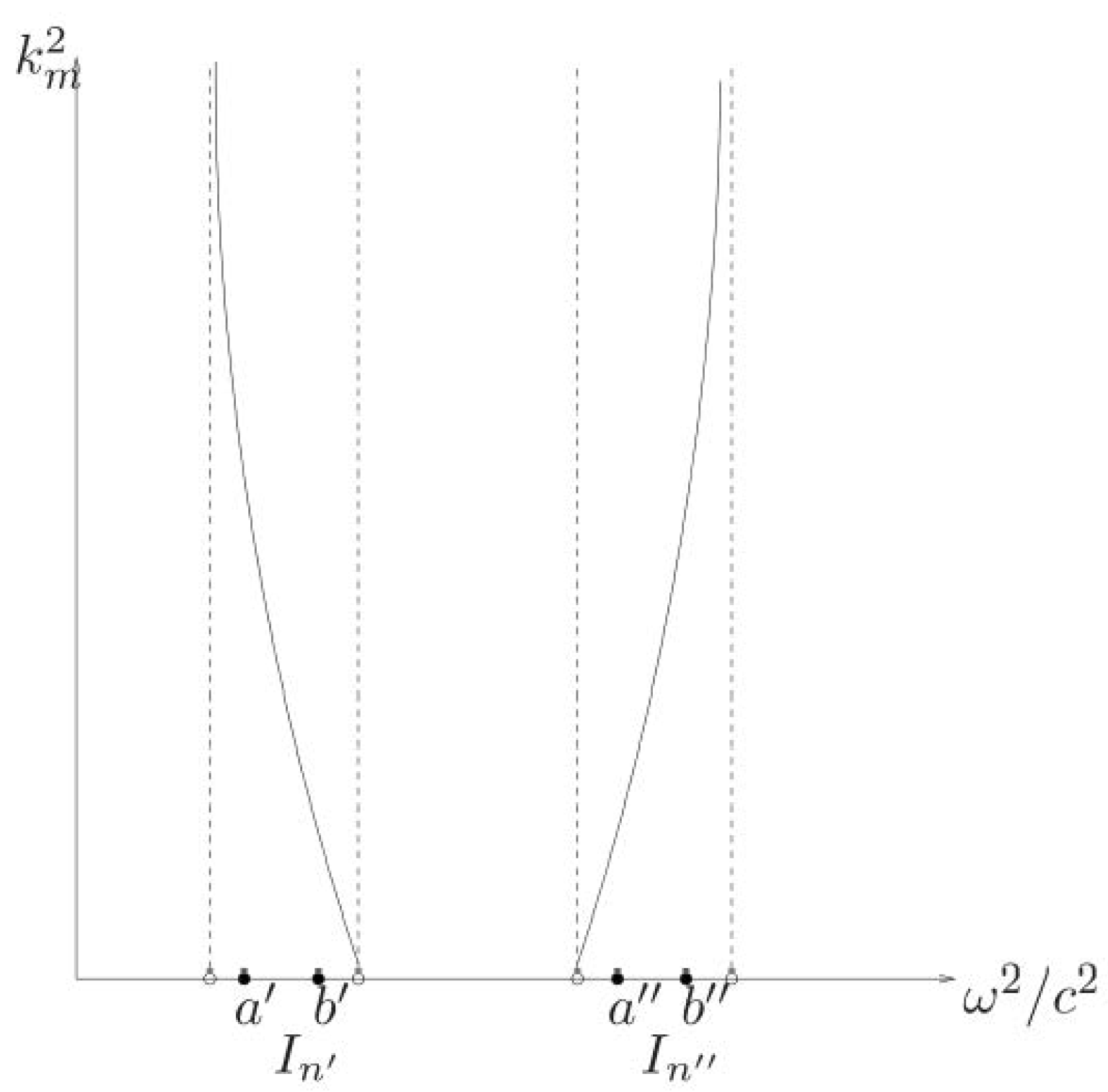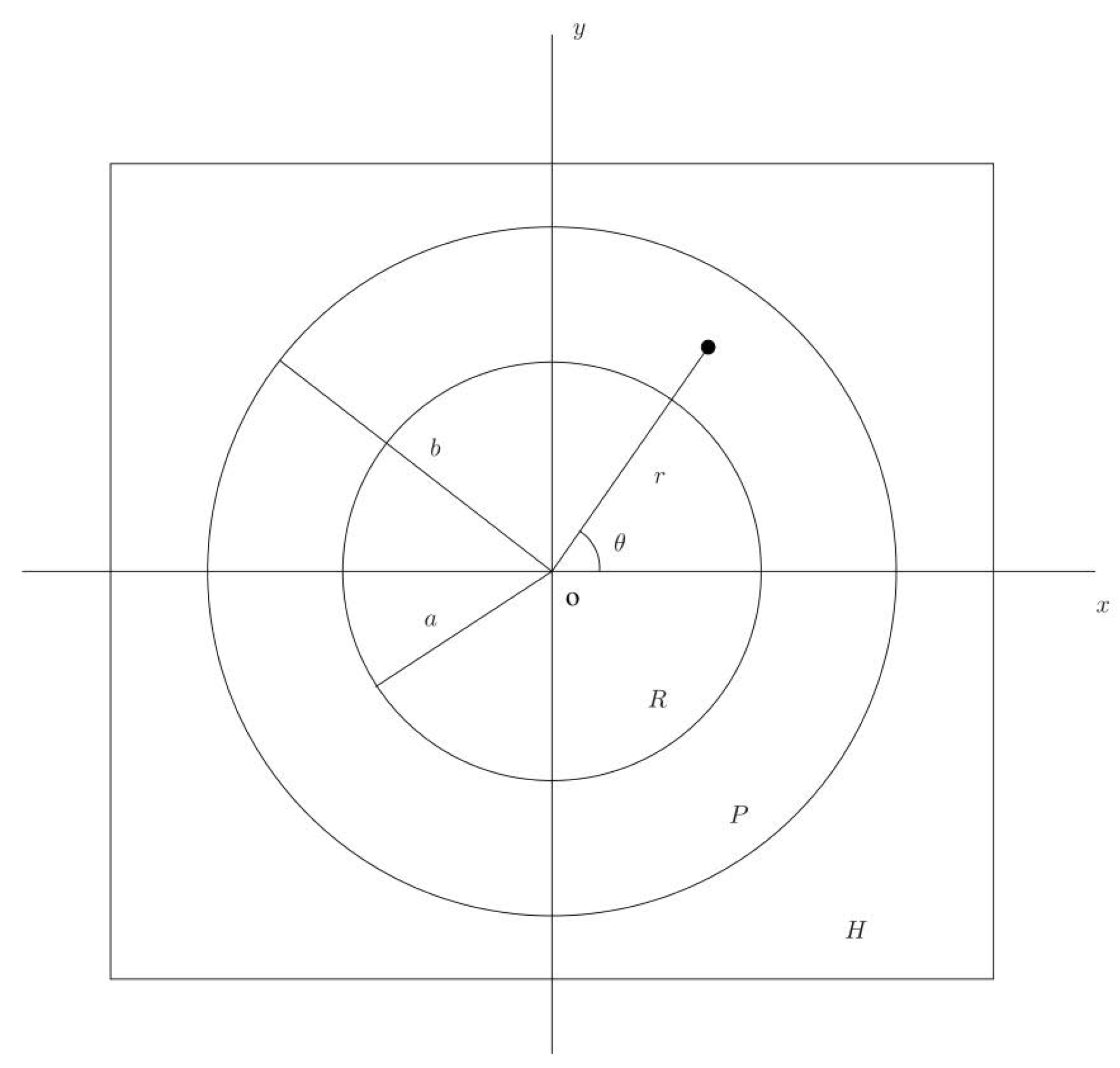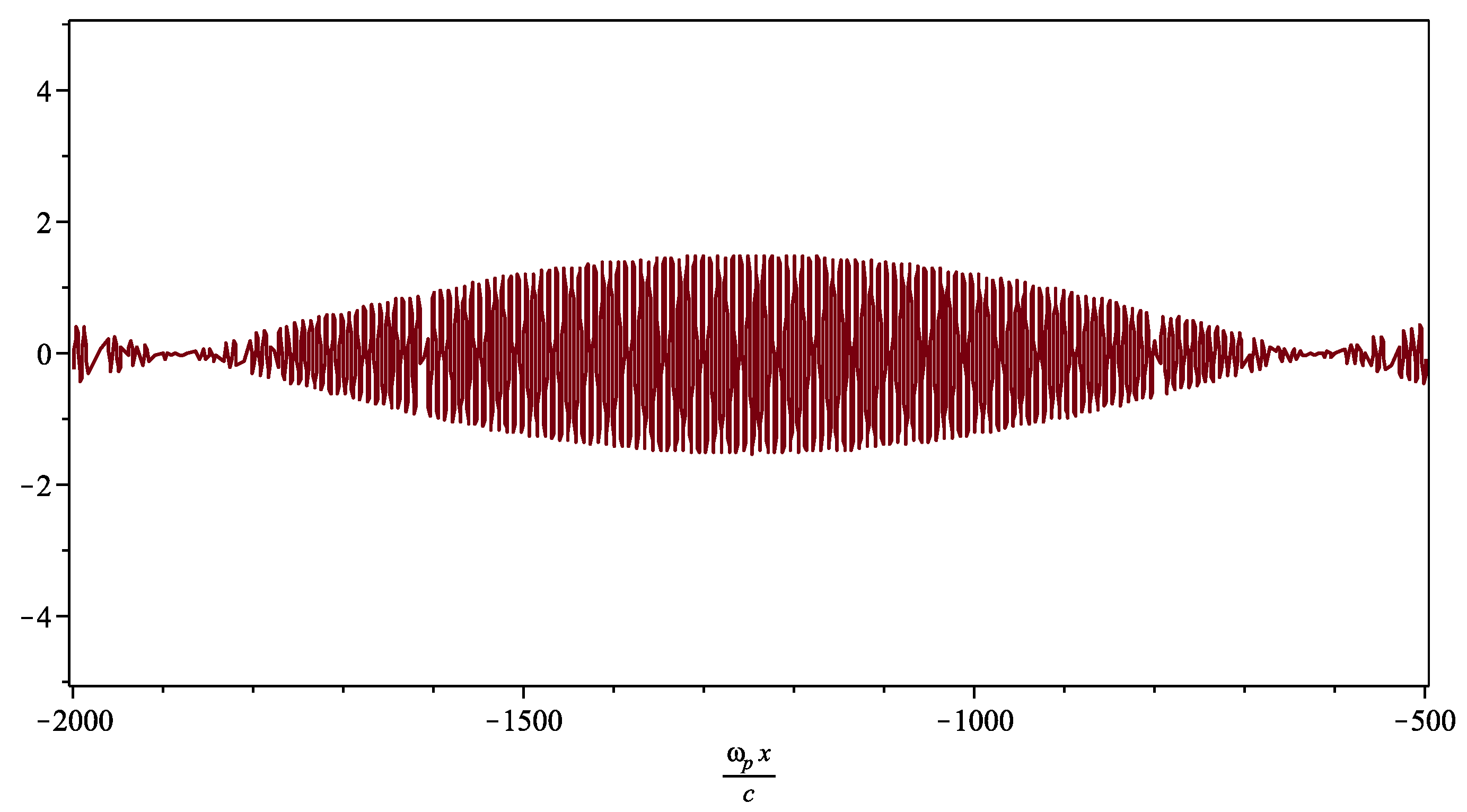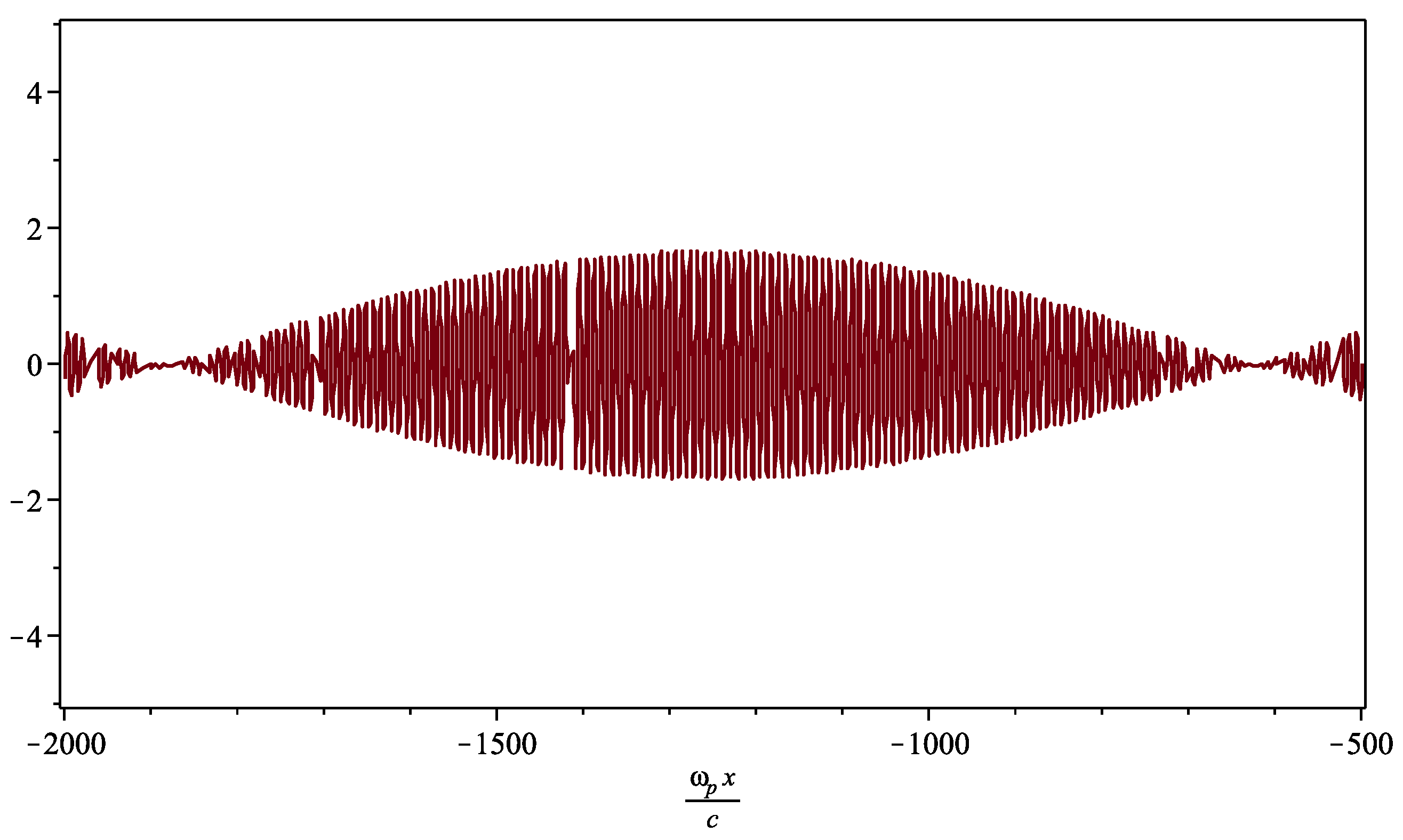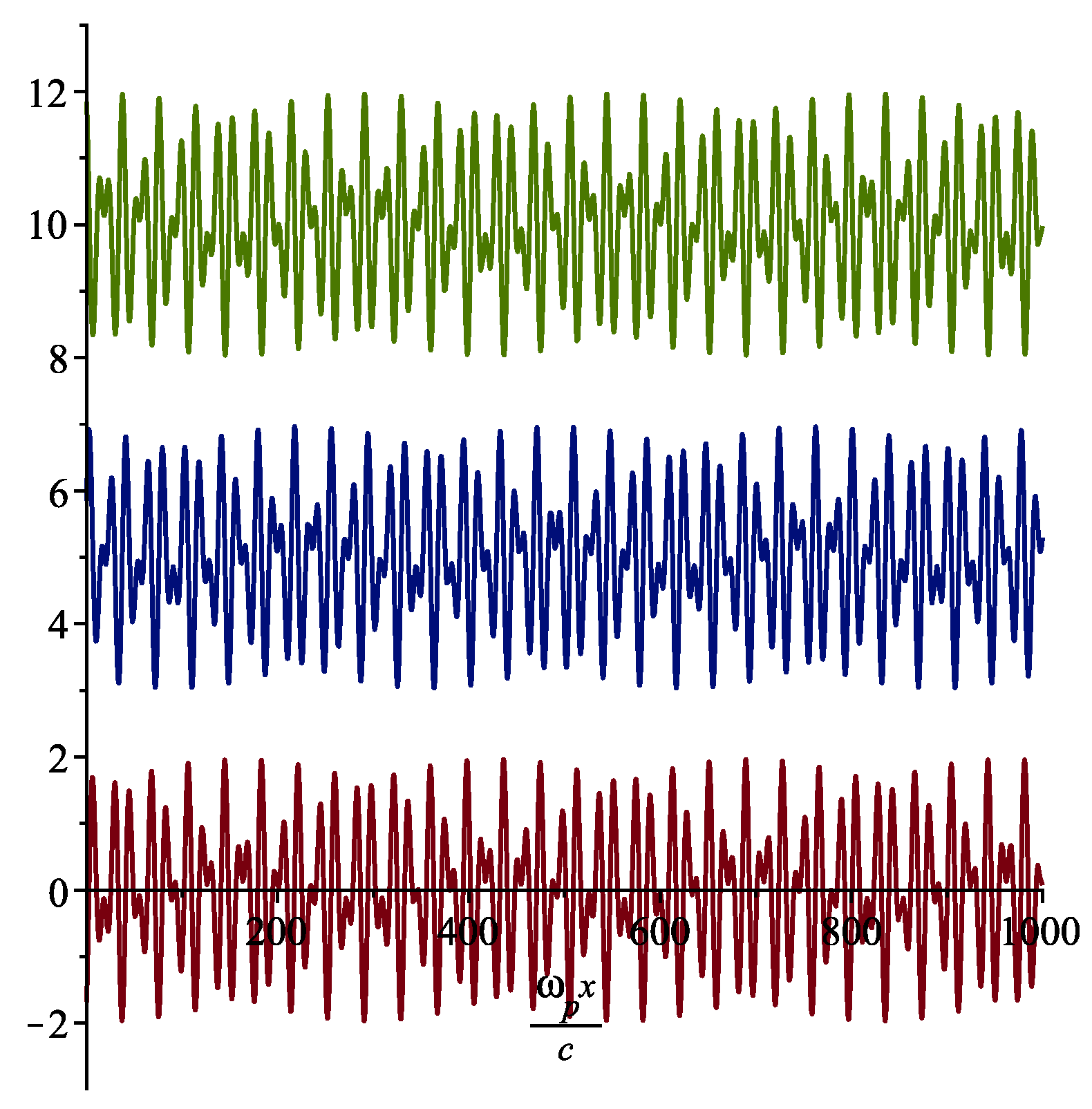1. Introduction
Metamaterials are patterned materials whose dispersive properties are controlled by their internal structure. The distinctive feature is that signal propagation within the metamaterial is governed by micro or nano resonators smaller than the smallest wavelength of the propagating signal. Familiar examples include stained glass and colloidal suspensions which derive their coloration from the plasmonic resonances of gold nanoparticles at optical frequencies, see [
1]. Experimental validation of negative index metamaterials created using the negative effective magnetic permeability of split ring resonators [
2] togeather with the negative effective dielectric constant from metal posts [
3] proposed in [
4] is given in the article of [
5]. Refraction of Gaussian pulses by negative index slabs are theoretically investigated in [
6]. Subsequent work has delivered several new designs using different configurations of metallic resonators and corrugated wave guides for double negative and effective magnetic behavior [
7,
8,
9,
10,
11,
12,
13,
14,
15,
16,
17,
18,
19,
20] in the microwave regime.
For higher frequencies in the infrared and optical range, new strategies for generating materials with double negative bulk properties rely on Mie resonances. One scheme employs coated rods made from a high dielectric core coated with a frequency dependent dielectric plasmonic or Drude type behavior at optical frequencies [
21,
22,
23]. A second scheme employs small rods or particles made from dielectric materials with large permittivity, [
24,
25,
26]. Alternate strategies for generating negative bulk dielectric permeability at infrared and optical frequencies use special configurations of plasmonic nanoparticles [
27,
28]. The list of metamaterial systems is growing and reviews of the subject can be found in [
29,
30]. Studies on random configuration of dielectric materials has been pursued recently in [
31,
32,
33].
In the present work we are interested in the refraction of signals of a given center frequency and bandwidth traveling from free space into a metamaterial. We construct our metamaterial from non-magnetic sub-wavelength arrays of scatterers that exhibit both local Mie resonances as well as local plasmon resonances associated with a Drude dielectric. These resonances interlace and generate the passbands and stop bands of the metamaterial [
34,
35,
36,
37]. The resonances are shown to control the signs of the effective magnetic permeability and dielectric constant. For frequency bands where the effective properties are simultaneously positive one has a positive dispersion while one has a negative dispersion for signals over frequency bands where effective properties are simultaneously negative, see [
34,
35,
36,
37]. The Mie resonances are generated by high dielectric fibers coated with a frequency dependent dielectric. This patterned sub-wavelength heterogeneous media delivers an effective index of refraction that can either be positive or negative across different frequency bands in the near infrared and optical regime. In this paper we outline the explicit connection linking these frequency bands to the sub-wavelength geometry and associated resonances. We illustrate the resulting positive to negative index metamaterial and the associated positive to negative angle of refraction for signals transmitted into the metamaterial over different frequency bands.
2. Metamaterials and Frequency Dependent Effective Index of Refraction
The metamaterial treated here is constructed from a two-dimensional photonic crystal made of parallel coated rods, see
Figure 1. There can be one or more parallel coated rods inside the crystal period. All materials used here are nonmagnetic and have relative magnetic permeability equal to 1. We will obtain an effective magnetic response using resonant sub-wavelength geometries. The time harmonic field is TE-polarized and the magnetic field inside the crystal is parallel to the rods
where
in the
-plane transverse to the rods.
The period for the crystal is
d and the dielectric coefficient
takes the values
The coating is a cylindrical shell of plasmonic material with dielectric constant . Here is the plasma frequency associated with the coating material and c is the speed of light in vacuum. The dielectric constant of the rod is chosen according to where has units of area. The idea is to choose the dielectric permittivity of the rod to be large relative to the period size so that the corresponding Mie resonances are excited in the sub-wavelength limit. The dielectric constant of the host material is given by .
The time harmonic magnetic field
for the
d-periodic crystal is a Bloch wave
where
h is
d-periodic in
, the wave number in the metamaterial is given by
, where
is the wavelength in metamaterial. The direction of propagation in the
-plane is described by the unit vector
. The magnetic field satisfies the Helmholtz equation
with propagation bands described by dispersion relations relating
to
. We examine the sub-wavelength case when
, where
is the wavelength in free space. The power series approach [
34,
36,
37] is used to find the explicit Bloch wave solution of Maxwell’s equation as a convergent multiscale power series in
. The
term in the expansions for dispersion relation and field deliver the“homogenized sub-wavelength” dispersion relation for plane waves inside an effectively magnetic double negative medium, see [
34,
36,
37].
In the effective medium, the dispersion relation relating frequency
to wave number
is
where
is the effective index of refraction, and this is derived rigorously in [
34].
The homogenized wave is a plane
B field wave:
where
is a constant in space and time. The homogenized
B field is related to the homogenized
H field by
where
is the effective magnetic permeability [
36]. Here
and the effective constitutive relation
The effective dielectric permittivity is
and
The explicit formulas for the frequency dependent effective magnetic permeability depend on the Dirichlet spectrum of the high contrast inclusion and the frequency dependence of the effective dielectric constant depend on the generalized electrostatic resonances (plasmon) resonances of the dielectric coating [
34,
36]. These formulas are presented in the next section.
3. Controlling Frequency Dependent Effective Properties and Positive and Negtive Dispersion
The frequency dependent effective magnetic permeability
and effective dielectric permittivity
are determined explicitly in terms of local resonances. We first rescale to a unit period cell to define effective properties. The unit cell is
. The subset of
Y containing the high contrast dielectric is
R, the coating containing the Drude dielectric is
P and the host material occupies
H. These three regions make up the unit cell
Y, see
Figure 2.
The Dirichlet eigenfunctions
,
with nonzero mean and associated eigenvalues of the Laplacian defined on
R. The set of eigen functions and eigenvalues are denoted by
and
respectively for
. The effective magnetic permeability is given by
where
denotes the average over
R,
and
are the areas occupied by regions
H and
P, respectively.
The generalized electrostatic resonance of the coating is the eigenfunction
eigenvalue
pair solving
with the boundary and transmission conditions
Here
is the outward directed normal derivative. The generalized electrostatic eigenvalues
lie in the open interval
with zero being the only accumulation point, see [
34]. The eigenfunctions
form a complete orthonormal set of functions in the space of mean zero square integrable periodic functions on the set
. Similar types of electrostatic resonances are well known in the context of effective coefficients of DC two phase media [
38,
39].
We form the integrals
and the frequency dependent effective dielectric constant is
The index of refraction for the metamaterial is given by (
6), and the dispersion relation (
4). Here the the link between dispersion relation and the subwavelength geometry is explicitly given in terms of the local resonances defining the effective properties through the Formulas (
8) and (
12). These formulas are derived in [
36,
37]. It is clear that we can control the frequency dependence of
and
by controlling the poles and zeroes of these functions which depend on the Dirichlet resonances (
7) and generalized electrostatic resonances (
10) respectively. The graphs of
and
as functions of
are displayed in
Figure 3 and
Figure 4. Here the intervals
and
are the same in all graphs.
It follows that dispersion relation is also controlled by the poles and zeros of
and
as explicitly determined through the Dirichlet spectra and generalized electrostatic resonances. The Formulas (
4) and (
6) show that the frequency intervals associated with pass bands and stop bands are governed by the poles and zeros of the effective magnetic permittivity and dielectric permittivity tensors. Pass bands of fixed center frequency and band width occur when the effective magnetic permittivity and dielectric permeability have the same sign. This includes frequency intervals where effective tensors are either simultaneously positive or negative. When both are positive one has positive dispersion and negative dispersion when both are negative. Bands of positive and negative dispersion are separated by stop bands, see
Figure 5.
In the following sections we will choose the the high contrast core phase to be a disk centered in the period cell surrounded by an annular coating of Drude dielectric. The ratios of the disk radius and the outer diameter of the coating to the period length are fixed. We then calculate the Dirichlet and electrostatic eigenvalues to calculate a frequency dependent effective index of refraction. For the concentric Drude dielectric coating-high dielectric core geometries we can control the spectra by changing the ratio of core to coating material used, see
Figure 6. Here we denote the core radius by
a and the outer radius of the coating by
b where these numbers are in dimensionless units relative to period length. In this context we can change the outer radius of the coating and radius of the core relative to the period size. The band width and center frequency of the negative index band and its dependence on
a and
b listed in
Table 1. This demonstrates that we can control the frequency bands where the effective index of refraction is negative (or positive) by changing the inner and outer radii of the coating material.
These calculations highlight the frequency dependent refraction of signals composed of waves with frequencies inside different frequency bands by a free space - metamaterial system. In the following sections we demonstrate how to calculate the explicit refraction of signals passing between a free space - metamaterial interface in the time domain. We show that the same metamaterial can refract signals both positively or negatively depending only on the frequency band of the incoming signal.
In the following sections we will choose the the high contrast core phase to be a disk centered in the period cell and an annular coating. The ratios of the disk radius and the outer diameter of the coating to the period length are fixed. We then calculate Dirichlet and electrostatic eigenvalues to calculate a frequency dependent effective index of refraction. These calculations are used to highlight the frequency dependent refraction of signals composed of waves with frequencies inside different frequency bands by a free space - metamaterial system.
4. Normal Incidence on a Half Space of Metamaterial
We consider the left half space to be free space and the right half space filled with metamaterial. The interface between half spaces is parallel to the axis and the normal to the interface is taken to be the axis and the interface between half spaces is given by the plane. We first suppose a group of waves of different frequencies propagate along the -axis, and so the H field is along the -axis and the problem reduces to one dimension.
First we consider waves inside the metamaterial. Since we have normal incidence we replace
by
and
by
x. We let
and write
Energy propagation is in the direction of increasing
x so if
,
then
while if
,
then
, see [
36,
37]. On the other hand the vacuum is nonmagnetic, i.e.,
so the
B and
H fields are the same and
where
k is the wave number in vacuum and the free space dispersion relation is
.
The wave forms inside both media are a superposition of plane waves. For each
k the plane waves are of the form
for
and
for
. For each
k the coefficients
and
are determined by the two transmission conditions
and
From Maxwell’s equations we have the identity inside vacuum and metamaterial
where
Then the last jump condition (
15) is equivalent to
Collecting the results we give the waveforms incident reflected and transmitted across the interface between vacuum and effective material .
Proposition 1. Waveforms in vacuum and effective material.Thecomponent of the H field is the only non zero component of the H field wave form in vacuum () and iswhere the amplitudedecribes the properties of the linear superpostion of the different waves. Thecomponent of the H field is the only nonzero component of the H field wave form in the metamaterialand is Hereat the interface
Thecomponent of the E field is the only nonzero component of the E field in vacuumand is Thecomponent of the E field is the only nonzero component of the E field in the metamaterialand is Hereat the interface
Now we introduce
and
and we can write
and
Note that if and .
In our paper, we consider a signal made of a group of waves with frequencies lying inside a prescribed band of frequencies for which
where
In order to make the H-field dimensionless, we can use
to denote the time change, and
the position change. Let
be the center frequency. Then the transmitted wave packet (
19) can be written as
Similarly the reflected wave packet is
The incident wave packet without reflection is
In our example, we take , and . Let the dimensionless center frequency . We use Riemann sum to approximate the integral by the sum of two rectangles.
Let
. The incident wave packet without any reflections is
where
is a constant.
Figure 7 is the graph for
for
.
Let
. The incident wave packet with the interaction of reflection is
Figure 8 is the graph for
for
which is H field in vacuum with interaction between incident and reflective waves.
Let
. Then we have
where
is a constant.
Figure 9 and
Figure 10 are the graphs for
for different
, i.e., the transmitted wave motion in metamaterial (
).
Figure 9 shows transmitted wave motion from the bottom to the top for
ranging from 5 to 9 in the steps of 2. It can be observed that the group velocity of the transmitted wave in metamaterial has the forward direction (the envelope moves forward).
Figure 10 shows the transmitted wave motion from the bottom to the top for
ranging from 5 to 7 in the steps of 1. We can see that the phase of the transmitted wave in metamaterial moves backward.
The H field at the interface between the vacuum (
) and effective double negative material (
) is shown in
Figure 11. The graph shows the continuity of the magnetic field at the interface. But it is not differentiable at the interface.
5. Oblique Incidence on a Metamaterial: A Positive to Negative Index Refraction
Consider the 2D motion of the H-polarized field given by
and
. In the vacuum, the third component of the incident H field is given by
where
k is the wave number in vacuum (
),
, the incident wave propagation direction
and
is the angle of incidence between the incident wave and the normal vector
of the interface (
). After the incident wave hits the interface (
), the reflected wave has the form of
where
is the reflection coefficient, the reflected wave propagation direction
and
is the reflective angle between the reflective wave and the interface normal.
In the negative index metamaterial (
), the transmitted wave has the form of
where
is the transmission coefficient,
is the wave number in the media, the propagation direction in the effective media
,
is the refractive angle between the refractive wave and the interface normal and by the Snell’s Law
.
From the Maxwell equation, at the interface (
), we have the transmission conditions
and
The transmission condition (
33) shows
which implies that
Since
by Snell’s Law, (
36) becomes
So the transmission condition (
34) shows
Then we have
which implies
The linear system (
37) and (
41) has the solution
and
Collecting results we have
Proposition 2. Waveforms in vacuum and effective material in 2D.Thecomponent of the H field is the only non zero component of the H field wave form in vacuum () and is Thecomponent of the H field is the only non zero component of the H field wave form in the metamaterialand is Hereat the interface, andand We consider the signal composed of waves inside a frequency band for which
is defined by (
23). The transmitted signal (
45) can be written as
Similarly the signal in the vacuum can be rewritten as
In this example, we take as before
,
and
. Let the dimensionless center frequency be
and the incident angle
. We use a Riemann sum and approximate the integrals by the sum of two rectangles. So
where
and
is a constant. Notice that
. Therefore,
when
and
when
. And
where
Figure 12 shows the contour map of H field at the interface between the vacuum (
) and the effective double negative material (
).
Now consider another signal but with with
and
. The paper [
36] shows that when the dimensionless frequency
lies in the interval
, the effective permittivity and effective permeability of the material are simultaneously positive. Let the dimensionless center frequency
and the incident angle
. Note that the refractive angle
when
and
when
.
Figure 13 gives the contour map of
H field at the interface between the vacuum (
) and the effective double positive material (
).
